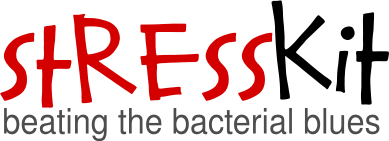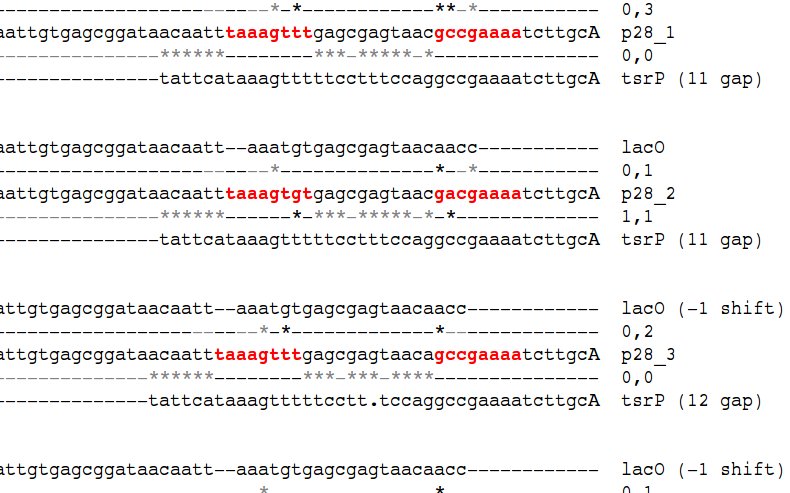Team:IIT Madras/Project
From 2008.igem.org
Sayashkumar (Talk | contribs) (→Promoter Design) |
Sayashkumar (Talk | contribs) (→Promoter Design) |
||
| Line 43: | Line 43: | ||
==Promoter Design== | ==Promoter Design== | ||
{|align=center width=80% | {|align=center width=80% | ||
| - | |The promoter sequences of a number of genes regulated by the different & | + | |The promoter sequences of a number of genes regulated by the different σs were compiled. See the adjacent table for the list of genes that we obtained from <tt>ecocyc.org</tt> and other literature references. |
Their mode of regulation was also looked into. Apart from being just selected for transcription by a &sigma factor, most of the genes are ''trans'' regulated with both repressors and activators. This poses an additional complexity in the isolation of a promoter segment as ''cis'' regulatory elements need to be incorporated. | Their mode of regulation was also looked into. Apart from being just selected for transcription by a &sigma factor, most of the genes are ''trans'' regulated with both repressors and activators. This poses an additional complexity in the isolation of a promoter segment as ''cis'' regulatory elements need to be incorporated. | ||
Revision as of 04:58, 16 September 2008
| Home | About Us | Project Details | Notebook |
|---|
Project Details
Introduction
After months of brainstorming and evaluating a large number of other ideas, we defined our problem statement as follows,
Is it possible to make bacteria respond to physical changes in a customizable way? First, we analyze the question piecewise. How exactly do bacteria adapt to physical changes in their environment? Typically, these physical parameters comprise of temperature, pH, salt concentration, oxidation potential and nutrient concentration. These stresses pose a challenge to the organisms' survival. The lead for the idea was when we came across heat shock and the response it elicits in lactococcus. This phenomenon of temperature rise being related to DnaK levels was exactly the kind of system we wanted to develop on. How are bacteria able to selectively switch on expression of a small subset of proteins based on a change in temperature, or any other physical parameter? The very ability of bacteria to accomplish this points to a transduction mechanism. They must transduce physical changes into gene expression. In this light, it is interesting to know that σ 32, a subunit of the RNA Polymerase Holoenzyme, twists into a functional conformation only on a rise in temperature. Further, this σ subunit confers sequence selectivity to RNA Polymerase, directing it to different promoter sites. Without this σ factor, RNA Polymerase has a very indiscriminate binding behaviour. To deal with different environmental niches, bacteria employ a family of such σ factors. They express different sets of proteins in an attempt to adapt to these varying conditions. The exact number of these factors changes from one species to another, with the more exotic ones having a larger number. This reflects on the degree of specialization of an organism to survive different conditions. For example, E. coli has 7 σ subunits while S. coelicolor has over 60. E.Coli has a family of 7 σ subunits to partition it's genome into various programs. This division is as follows,
We used the database ecocyc.org to survey the genes being controlled by these different sigmas and how exactly are they induced. Identifying and isolating the promoters of these genes would be the next step. A library of promoters which would be expressed by these different sigmas would make for novel BioBricks. These new promoters would cover the different environmental stresses that E.Coli responds to. Being designed within the specifications set out by the parts registry, it would be extensible with all the existing devices. A point to appreciate is that these promoters, unlike pLac, are expressed without any external chemical for induction and yet are not constitutive. This sets it apart in a league of environmental context specific promoters without the need for external inducer. |
Promoter Design
| The promoter sequences of a number of genes regulated by the different σs were compiled. See the adjacent table for the list of genes that we obtained from ecocyc.org and other literature references.
Their mode of regulation was also looked into. Apart from being just selected for transcription by a &sigma factor, most of the genes are trans regulated with both repressors and activators. This poses an additional complexity in the isolation of a promoter segment as cis regulatory elements need to be incorporated. To resolve this, we looked into the kind of structural requirements for σ factor + RNA Polymerase to bind DNA. Activation is key for expression from genes under σ54. For the others, the pattern of RNA Polymerase binding is similar to that of σ70, which involves base specific interactions only in the -10 and -35 promoter region. |
 "
"

